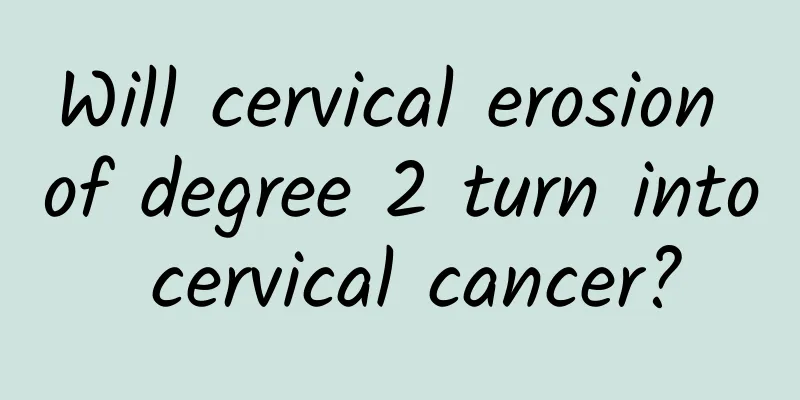Will cervical erosion of degree 2 turn into cervical cancer?

|
Will cervical erosion of degree 2 turn into cervical cancer? If cervical erosion is not treated promptly and correctly, the condition will gradually develop and may become cancerous. Cervical columnar epithelial ectopia is one of the local characteristics of chronic cervicitis. Cervical columnar epithelial ectopia is a normal physiological phenomenon with no special clinical manifestations. Some people may have contact bleeding, but only individual differences in the cervix can induce cervical cancer and lead to infertility. If there is an increase in leucorrhea, yellowing, and odor, it is a manifestation of cervical inflammation. Cervical cysts and hypertrophy are also the result of chronic cervical inflammation. Cervical erosion does not require any treatment, but for symptomatic cervicitis, treatment is required. Physical therapy methods such as laser or freezing can be used for chronic inflammation. Regular cervical examinations are necessary, not to prevent cervical columnar epithelial ectopia, but to prevent cervical cancer. The occurrence of cervical cancer is related to infection with human papillomavirus. Some high-risk HPV-infected patients are prone to precancerous lesions and cervical cancer when they are persistently infected at the junction of the cervical squamous column. The mortality rate of cervical cancer has dropped significantly since the cervical smear. The key is to prevent and treat it in advance. It is recommended that women over the age of 21 undergo a cervical smear examination once a year, combined with HPV testing when necessary. If HPV and cervical smears are negative for three consecutive times, the interval can be extended to 3 years. Cervical cancer still occurs occasionally after the age of 70. Patients with cervical erosion should pay attention to sexual hygiene, properly control their sexual life, resolutely put an end to extramarital sex, and avoid sexual intercourse during menstruation. Timely and effective contraceptive measures should be taken to reduce the incidence of artificial abortion and induced labor, and reduce the chance of artificial trauma and bacterial infection. If the menstrual cycle is too short or the menstrual period lasts for a long time, active treatment should be given. |
<<: What to do if you have back pain due to adenomyosis
>>: What are the reasons for delayed menstruation?
Recommend
Nursing measures for adolescent patients with functional uterine bleeding
Dysfunctional uterine bleeding during adolescence...
What is the reason for two consecutive miscarriages? It may be caused by the following reasons
Spontaneous abortion is caused by poor physical c...
How to prevent adenomyosis
How to prevent adenomyosis? 1. Avoid unnecessary ...
Is there a high chance of pregnancy with bilateral ovarian cysts?
Gynecological diseases are what women fear the mo...
3CMX2CM Is pelvic effusion serious?
Pelvic effusion of three centimeters by two centi...
How to treat postmenopausal hot flashes?
As we all know, women enter old age after they re...
What are the hazards of uterine fibroids? Is uterine fibroids a common clinical disease?
Uterine fibroids are a common clinical disease, w...
What to do with physiological ovarian cysts?
What to do with physiological ovarian cysts? Phys...
Contact bleeding is usually a manifestation of cervicitis
Contact bleeding is generally a manifestation of ...
Does endometrial tuberculosis affect pregnant women?
Endometrial tuberculosis is a common disease amon...
Keep your nerves tight! Taipei City conducts large-scale inspections of 22 businesses
The Taipei City Government Health Bureau speciall...
Causes of mild cervical erosion in women
Cervical erosion is a common disease among women,...
What do you need to bring to the hospital for an abortion? What do you need to bring to the hospital for an abortion?
What do I need to bring to the hospital for an ab...
Can I just buy some fruit and put it in the refrigerator? (Down)
As for soft fruits like persimmons, peaches, and ...
Super foul goddess! Korean supermodel Han Hye-jin's two secrets to body shaping
Han Hye-jin, a well-known Korean model, is known ...









